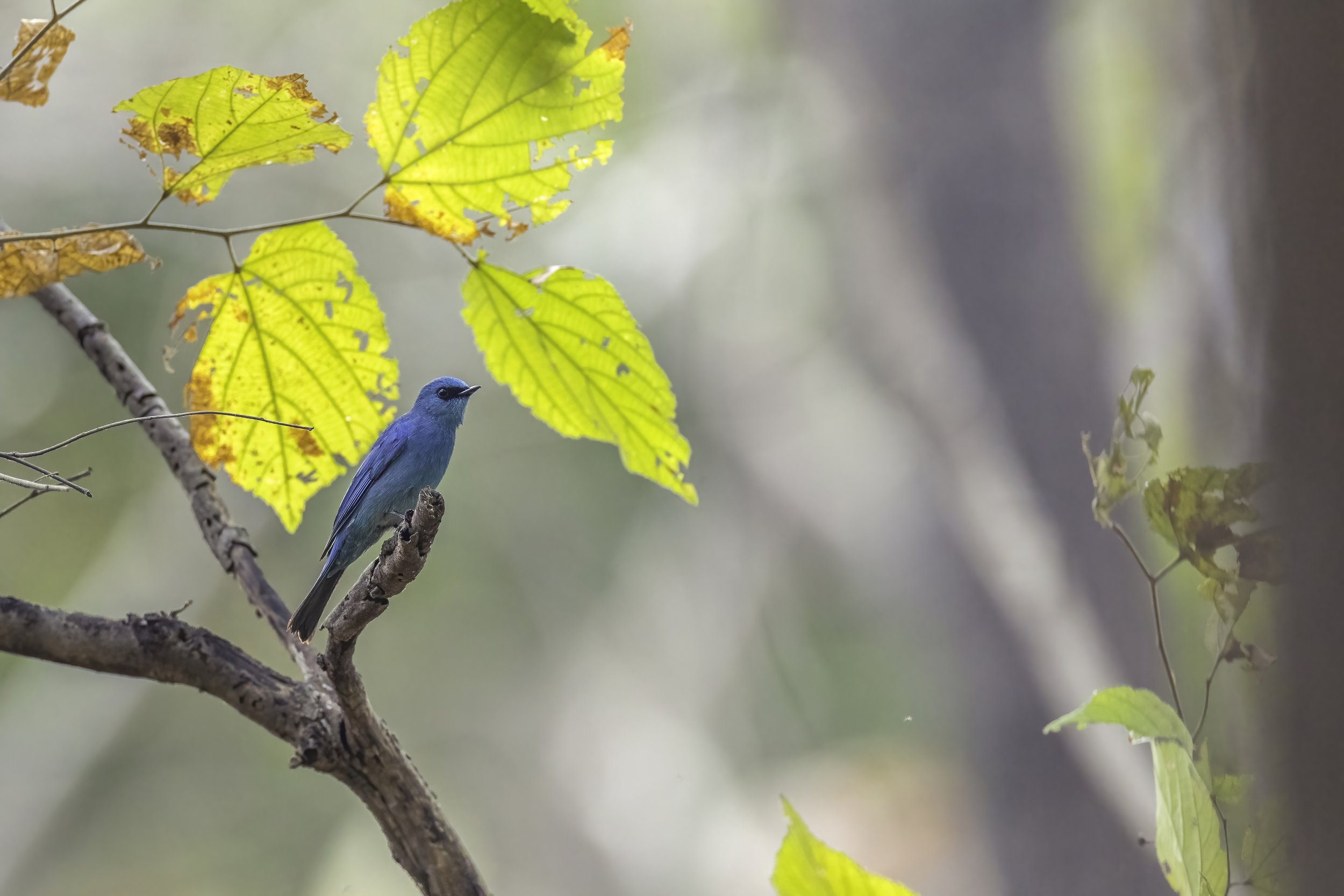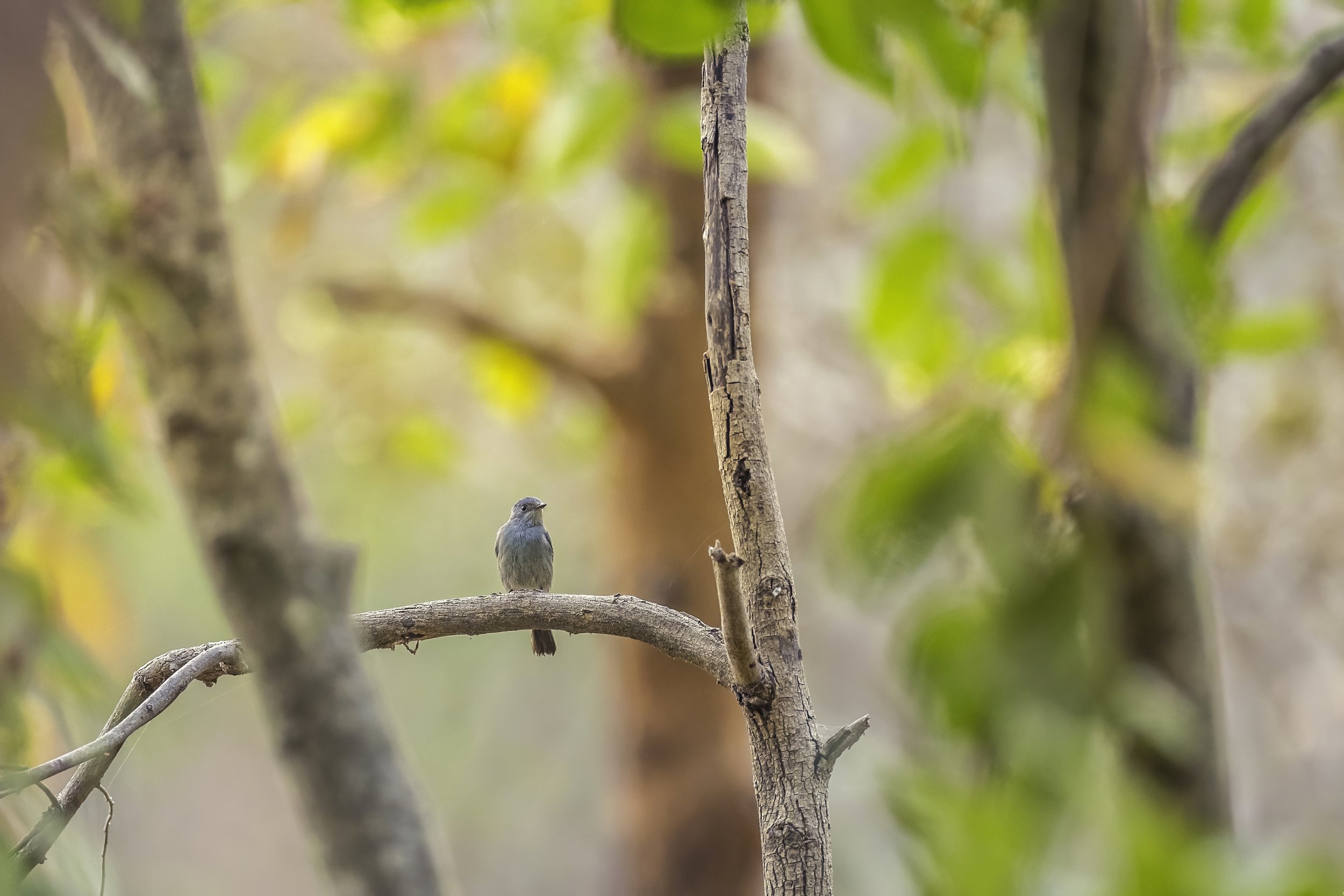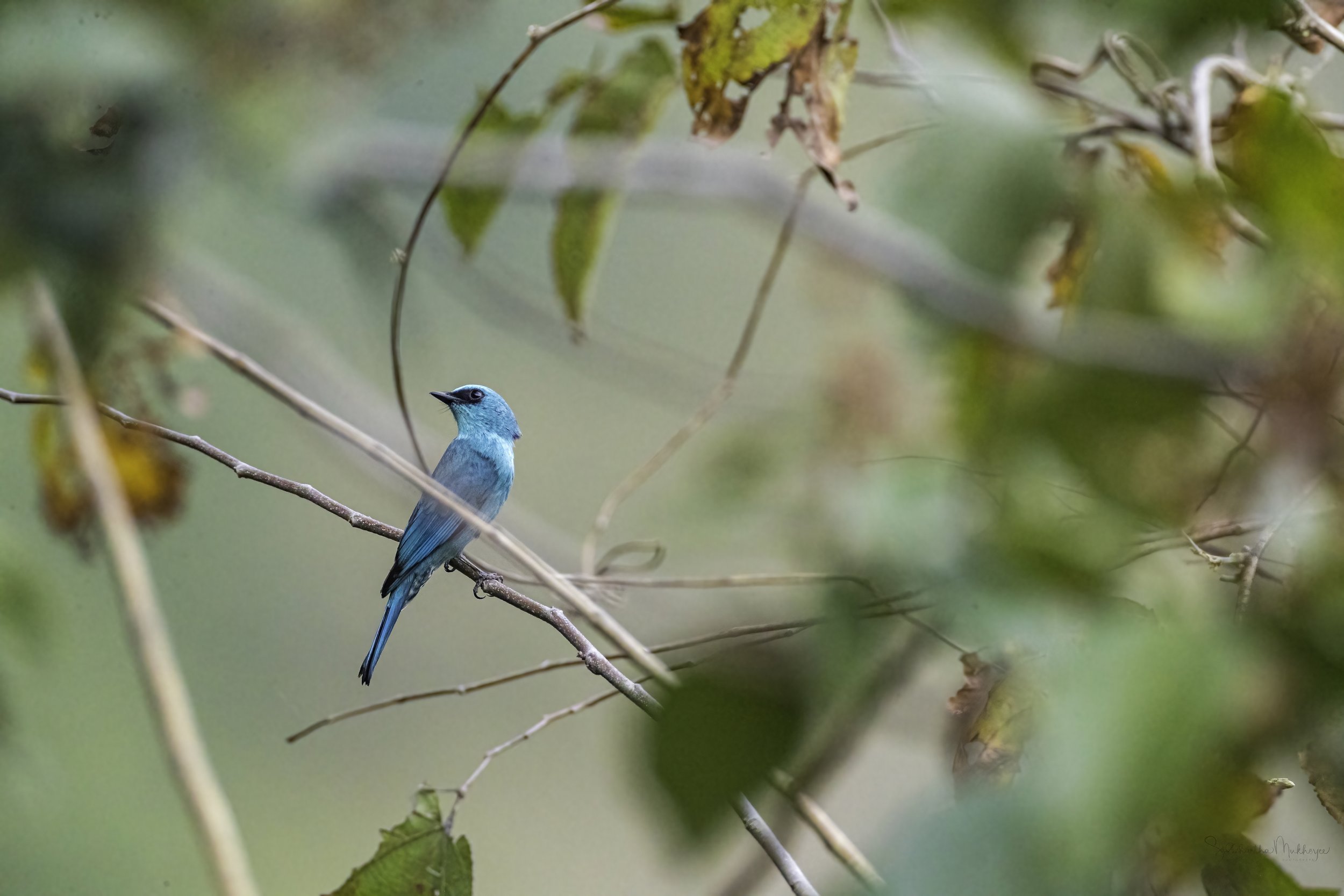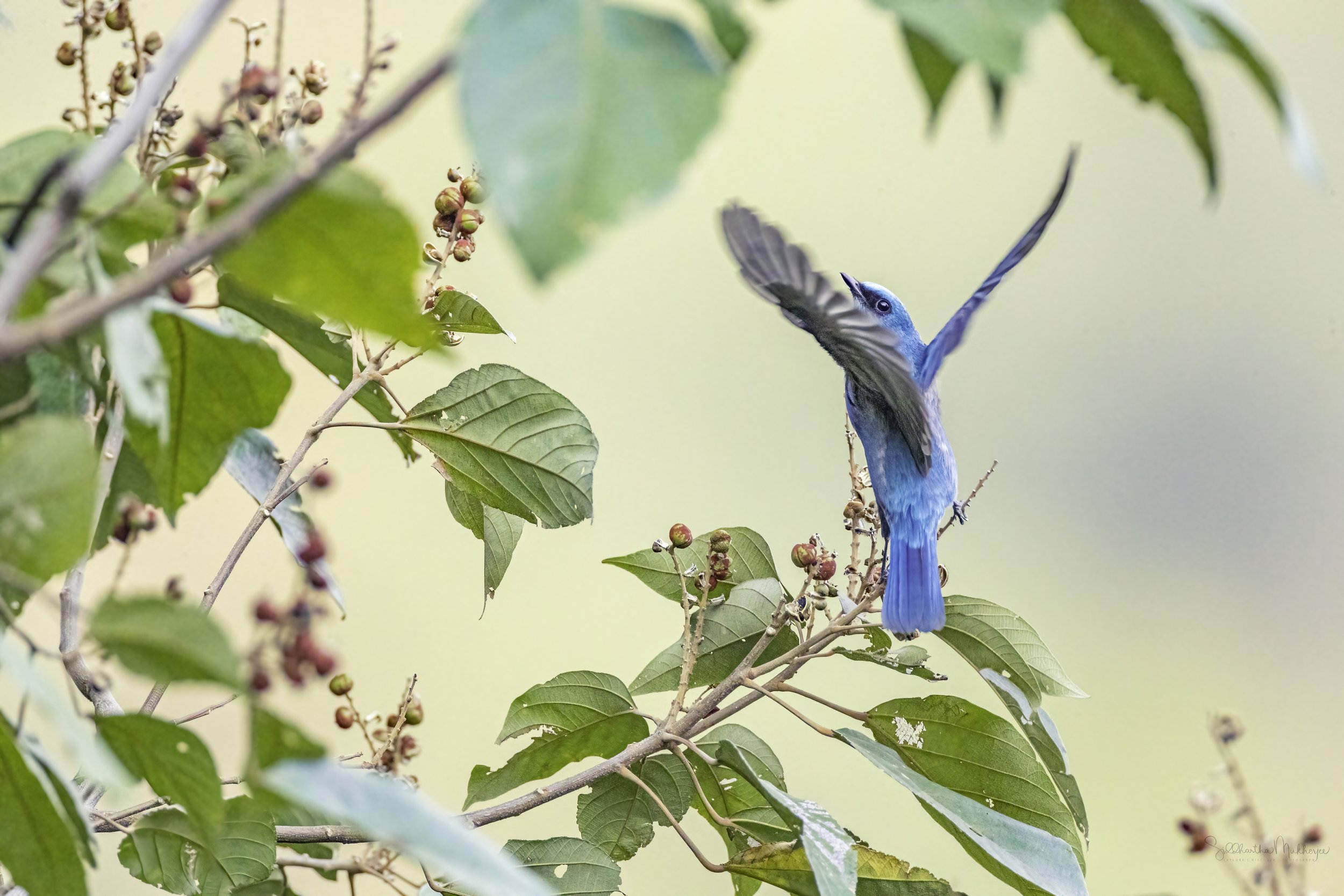Verditer Flycatcher
Eumyias thalassinus
Uma Maheshwaram Temple Complex, Ananthagiri Forest Range
The verditer flycatcher (Eumyias thalassinus) is an Old World flycatcher It is found from the Himalayas through Southeast Asia to Sumatra. This species is named after its distinctive shade of copper-sulphate blue and has a dark patch between the eyes and above the bill base. The adult males are intense blue on all areas of the body, except for the black eye-patch and grey vent while the adult females and sub-adults are a lighter blue. The verditer flycatcher is also interesting among the flycatchers in that they forage above the canopy level and perching on electric wires or exposed tree top branches. This species was earlier placed in the genus Muscicapa and it has been suggested that it is closer to the Niltava flycatchers. But first a little bit about the area where we saw this beautiful flycatcher.
Located in the central stretch of the Deccan Plateau, Telangana has sub-tropical climate and the terrain consists mostly of hills, mountain ranges, and thick dense forests covering an area of 27,292 km². The annual rainfall ranges between 1,100 mm to 1,200 mm and the annual temperature varies from 15 C to 45 C. The State is drained by a number of rivers which include Godavari and Krishna.
Telangana is endowed with rich diversity of flora and fauna. It has dense teak forests on the northern part along the banks of river Godavari. As per the Champion & Seth Classification of Forest Types (1968), the forests in Telangana belong to three Forest Type groups, which are further divided into 12 Forest Types. The State Government has taken up a massive greening programme, 'Telangana Ku Harita Haram' in the State to plant and protect 230 crore seedlings over a period of 4 years. This initiative aims at achieving the twin objectives of increasing the forest cover and reduce pressure on the existing forest resources, through massive community participation by Vana Samrakshna Samithis (VSS) and Eco-Development Committees (EDCs) in Protected Areas and Watershed Development Committees in the Watershed areas. Recorded Forest Area (RFA) in the State is 26,904 km² of which 20,353 km² is Reserved Forest, 5,939 km² is Protected Forest and 612 km² is Unclassed Forests. In Telangana, during the period 1st January 2015 to 5th February 2019, a total of 9,420 hectares of forest land was diverted for non-forestry purposes under the Forest Conservation Act, 1980 (MoEF & CC, 2019). As per the information received from the State during that last two years, 12,730 ha of plantations including avenue plantations in the State.
Three National Parks and nine Wildlife Sanctuaries constitute the Protected Area network of the State covering 5.08% of its geographical area and our focus area today is the northern fringe of the Nallamalla forest located both in Telangana and Andhra Pradesh. It is part of the Eastern Ghats. The Nagarjunsagar-Srisailam Tiger Reserve, the largest tiger reserve in India spread over the five districts of Kurnool, Prakasam, Guntur, Nalgonda and Mahabub Nagar falls in its precincts.
Read about my other flycatchers here:
Verditer Flycatcher - Male
Verditer Flycatcher - Female
Verditer Flycatcher
The adult Asian verditer flycatcher, Eumyias thalassina, is a member of the Old World flycatcher family, Muscicapidae. This species can be found throughout southeast Asia, from the lower parts of the Himalayas to southern China and India (where some populations winter) and into Indonesia. These birds inhabit a variety of habitats, from forest and woodlands to parks and gardens.
As its name implies, this bird is a gorgeous blue-green colour - a beautifully vivid turquoise-blue flycatcher. Adult male has dark lores while the juvenile is duller, with noticeably grayer underparts. The male has a dark patch around its eyes and bill that the paler female lacks. The adults also have a grey vent. Young birds are almost grey with buff spots.
But these birds do not get their dramatic plumage colour from pigments; instead, this is a structural colour that results from the feather scattering light such that it appears blue.
What does structural color mean?
In living creatures, structural coloration is the production of colour by microscopically structured surfaces fine enough to interfere with visible light, sometimes in combination with pigments. For example, peacock tail feathers are pigmented brown, but their microscopic structure makes them also reflect blue, turquoise, and green light, and they are often iridescent.
Structural coloration was first observed by English scientists Robert Hooke and Isaac Newton, and its principle – wave interference – explained by Thomas Young a century later. Young described iridescence as the result of interference between reflections from two or more surfaces of thin films, combined with refraction as light enters and leaves such films. The geometry then determines that at certain angles, the light reflected from both surfaces interferes constructively, while at other angles, the light interferes destructively. Different colours therefore appear at different angles.
The verditer flycatcher is quite distinctive but may be confused with the black-naped blue flycatcher, Hypothymis azurea. However, the black-naped blue flycatcher has white underparts, a black "moustache" at the base of its upper mandible, a thin black "necklace" and a black cap.
Verditer Flycatcher - Ananthagiri Forest Range, Vikarabad
Verditer Flycatcher - Ananthagiri Forest Range, Vikarabad
Verditer Flycatcher - Ananthagiri Forest Range, Vikarabad
The verditer flycatcher is a sit-and-wait predator that has favourite perches from where they launch their aerial pursuits of flying insects. Verditer flycatchers are fairly unusual amongst Old World flycatchers because they forage above the forest canopy, often perching on electric wires or exposed tree top branches. These birds sit very upright and flick their tails frequently, especially upon landing. This species was earlier placed in the genus Muscicapa and it has been suggested that it is closer to the Niltava flycatchers.
Even though these birds are passerines, their song is a weak, thin whistle.
Two subspecies recognized.
Eumyias thalassinus thalassinus: Distributed in the Himalayas from N Pakistan (Murree Hills) E, discontinuously, to NE India (Arunachal Pradesh, Assam, Meghalaya), C and S China (S Xizang E to S Shaanxi and Hubei, S to Yunnan and Guangdong), Myanmar, Thailand (except C and S) and Indochina; non-breeding S to C and S India, Bangladesh, C Myanmar, C Thailand and SE China.
Eumyias thalassinus thalassoides: Distributed in S Myanmar (S Tenasserim), S Thailand, Peninsular Malaysia, Sumatra and Borneo.
Their food not well known but recorded items are small invertebrates, including sweatbees (Trigona), also ripe berries of Macaranga and Mallotus. Usually foraging solitary or in pairs, occasionally there are several pairs occupying the same area of open forest. Also associates loosely with other flycatchers, ioras (Aegithina), leaf-warblers (Phylloscopus) and drongos (Dicrurus). It is fairly conspicuous; foraging from fairly high, open and often exposed perches, including roadside wires, posts, treetops (including forest giants) and buildings. Actively hawks insects in flight, variably returning to original perch; also flutters in foliage to dislodge insects, and may drop to ground to pick up prey. They have an upright stance and flicks the tail, most frequently on landing.
The Verditer Flycatcher is not globally threatened and can be commonly spotted throughout the Himalayas, and common in much of South East Asia. It is however uncommon in China and a scarce resident in Sumatra and Borneo.
And now onto the video and photos of this exquisite flycatcher.
These birds were photographed in and around the temple complex of Uma Maheshwaram. This is a temple dedicated to the Hindu god Shiva located in the Nallamala Forest around 100 km from Hyderabad on the Hyderabad-Srisailam highway, about 4 kms from the village of Rangapur, Achampet.
Uma Maheshwaram is the northern gateway of Srisailam — one of the jyotirlingas, on a hill surrounded by high trees. Nearby hills shield the Uma Maheshwaram temple and the 500-metre stretch to PapaNasanam from sunlight for most of the day, maintaining a temperature lower than the surroundings through out the year. The area abounds in flora and fauna like this beautiful and vulnerable Yellow-throated Bulbul.
‡‡‡‡‡
For a print of the beautiful birds from my various sojourns click on the button below to read my process and order a limited edition canvas.
‡‡‡‡‡
Related Posts
























